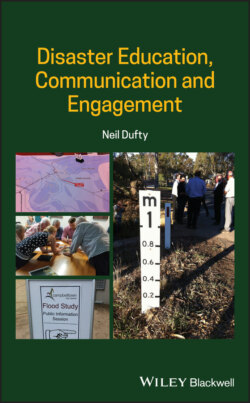Читать книгу Disaster Education, Communication and Engagement - Neil Dufty - Страница 15
2.2.1.4 Communicating Risk
ОглавлениеRisk communication seeks to inform people about a potential future harm and the associated dangers so that they might take action to mitigate the risk.
A long tradition in risk communication has relied on the idea that simply informing people will increase their understanding and awareness of risk. This approach assumes that experts (e.g. emergency agencies), holding superior knowledge, communicate to the less informed (e.g. at-risk people). However, it has been found that a direct, linear approach to providing official information to increase recipient awareness does not necessarily lead to action (Fischhoff 1995).
Furthermore, appreciation of the input of at-risk people in disaster risk has broadened the scope of risk communication. As a result, communicative activities that place responsibility for preparedness actions in the hands of citizens are gaining relevance (Begg et al. 2016). With this in mind, four approaches of risk communication can be distinguished related to the one-way and two-way communication dimensions (Terpstra et al. 2017).
1 Risk message approach. This type of risk communication is a one-way flow of information from an expert source so that it is received in a consistent and accurate manner. For example, details of flood risk can be communicated by a risk map which provides clear details of flood extent to all.
2 Risk dialogue approach. In this two-way risk dialogue approach, the distinction between risk experts and the at-risk public is a blur. Here, participation allows for the inclusion of local knowledge from the at-risk public that can improve the quality of risk assessments and risk maps, as well as of the management process itself.
3 Risk government approach. Communication within the one-way risk government approach aims at changing attitudes and behaviours. This is done by authorities creating awareness of people's hazard risks and the consequences that related decisions might have on their lives.
4 Instrumentalist risk approach. This two-way approach aims at actively changing people's behaviour and pays close attention to the ‘interactions between information, attitudes, and behaviour’ (Demeritt and Nobert 2014). Underlying the instrumentalist risk approach, many empirical studies focus on understanding the factors that motivate individuals to take responsibility and action in order to increase their disaster preparedness (Shreve et al. 2014).
